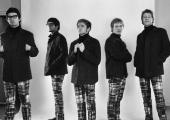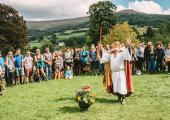Nick Mulvey, De La Warr Pavilion review - a band chasing the ecstatic

A singer-songwriter with a difference holds this seaside venue in thrall
British singer-songwriter Nick Mulvey’s new album, Wake Up Now, is one of the year’s finest. However, there’s a moment on the single “Myela”, a heartfelt Afro-Latin stomper protesting the plight of refugees, which can grate. The song suddenly stops and female backing singers begin a nursery rhyme chant of “I am your neighbour, you are my neighbour”. On record it seems trite; however, in concert at this eye-pleasing, airy Bexhill-on-Sea venue, it’s transformative. Mulvey and his five-piece band use the sequence as a launch pad for a cosmic jam, before settling into a brief snippet of Gary Clail & On-U Sound System’s “Rumours” (“of war”).
The song is one of this concert’s highlights and Mulvey introduces it by deadpanning, understatedly, that “truth is not rampant” in the world in 2017. His music, by contrast, is fervent in its truth-seeking. It seems to be aiming towards a higher purpose and, at its best, achieves elevation. He may look quite ordinary in his jeans, black shirt, beanie hat and dark beard, but his skill with a guitar is revelatory, and his quiet demeanour is belied by moments when the music takes off to somewhere else. In a funny sort of way – and not musically – there’s something of the Grateful Dead about it all, but Mulvey and co. have not yet reached the place where four-hour jams are de rigeur.
The set runs through most of the new album, dips into his first album, and even includes an unreleased song called “The Doing Is Done” which effectively combines drone harmonics with an African chant aesthetic. His sound is very WOMAD, a stew of global styles, built around his voracious appetite for learning new guitar techniques from across the world. His band is there every step of the way, notably his wife Isadora on ukulele and backing vocals, his multi-instrumentalist sidesman Frederico Bruno, and, most visual of all (including the frontman!), the striking, blond-maned valkyrie Fifi Dewey on synth and scorching electric guitar solos.
The band leaves the stage to allow for a rather tentative campfire-style audience sing-along to Mulvey’s most recognisable song, “Cucurucu”, which he has to restart due to a cough, but is there to add texture to quiet beautiful songs such as “We Are Never Apart” and the new album’s stunning meditation on death, “When the Body Is Gone”. They don’t play one of Mulvey’s most popuar older songs, "Nitrous”, but they get away with it because there’s enough potency to keep everyone happy in new songs such as “Unconditional” and the encore-opening, enthneogenic ballad “Infinite Trees” ("Seems to me a galaxy is calling us/Calling us on and on/Calling us into its infinity”).
If I had a quibble, it would be that there’s sometimes a solemnity which adds occasional unfunky weight when this band make music that's elastic, wide-eyed and lighter than air. This could just be because it’s the last night of the tour and, in any case, it’s nit-picking. It’s a great gig, and it climaxes with the second best song of this year, “Mountain to Move”, so we’re sent off onto the wildly windswept seafront singing its ecstatic chorus, “Wake up now!”, an anthem for our times.
Overleaf: watch the video for Nick Mulvey "Mountain to Move"









